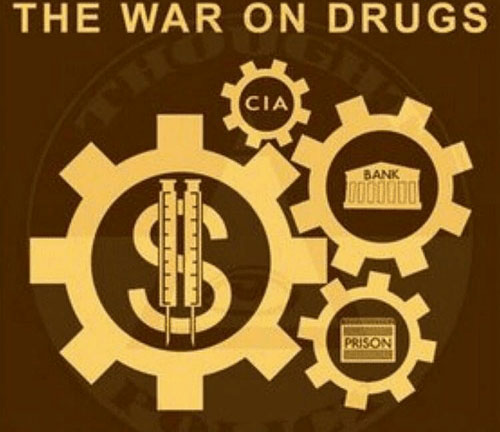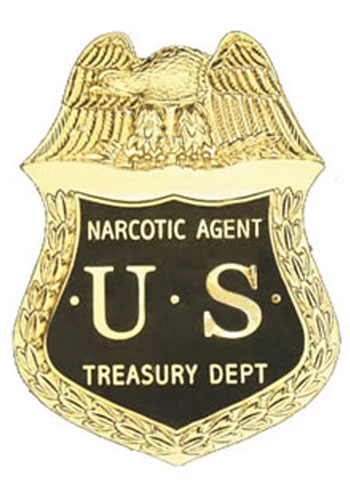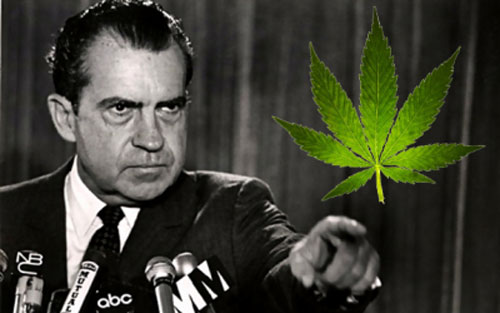Narcotics and Covert Intelligence: How the CIA Commandeered the War on Drugs (1)
The outlawing of narcotic drugs at the start of the XX century, the turning of the matter from public health to social control, coincided with American’s imperial Open Door policy and the belief that the government had an obligation to American industrialists to create markets in every nation in the world, whether those nations liked it or not.

Civic institutions, like public education, were required to sanctify this policy, while “security” bureaucracies were established to ensure the citizenry conformed to the state ideology. Secret services, both public and private, were likewise established to promote the expansion of private American economic interests overseas.
It takes a book to explain the economic foundations of the war on drugs, and the reasons behind the regulation of the medical, pharmaceutical and drug manufacturers industries. Suffice it to say that by 1943, the nations of the “free world” were relying on America for their opium derivatives, under the guardianship of Harry Anslinger, the Commissioner of the Federal Bureau of Narcotics (FBN).
Narcotic drugs are a strategic resource, and when Anslinger learned that Peru had built a cocaine factory, he and the Board of Economic Warfare confiscated its product before it could be sold to Germany or Japan. In another instance, Anslinger and his counterpart at the State Department prevented a drug manufacturer in Argentina from selling drugs to Germany.
At the same time, according to Douglas Clark Kinder and William O. Walker III in their article, Stable Force In a Storm: Harry J. Anslinger and United States Narcotic Policy, 1930-1962, Anslinger permitted “an American company to ship drugs to Southeast Asia despite receiving intelligence reports that French authorities were permitting opiate smuggling into China and collaborating with Japanese drug traffickers.”
Federal drug law enforcement’s relationship with the espionage establishment matured with the creation of CIA’s predecessor organization, the Office of Strategic Services. Prior to the Second World War, the FBN was the government agency most adept at conducting covert operations at home and abroad. As a result, OSS chief William Donovan asked Anslinger to provide seasoned FBN agents to help organize the OSS and train its agents to work undercover, avoid security forces in hostile nations, manage agent networks, and engage in sabotage and subversion.
The relationship expanded during the war, when FBN executives and agents worked with OSS scientists in domestic “truth drug” experiments involving marijuana. The “extra-legal” nature of the relationship continued after the war: when the CIA decided to test LSD on unsuspecting American citizens, FBN agents were chosen to operate the safehouses where the experiments were conducted.
The relationship was formalized overseas in 1951, when Agent Charlie Siragusa opened an office in Rome and began to develop the FBN’s foreign operations. In the 1950s, FBN agents posted overseas spent half their time doing “favors” for the CIA, such as investigating diversions of strategic materials behind the Iron Curtain. A handful of FBN agents were actually recruited into the CIA while maintaining their FBN credentials as cover.
Officially, FBN agents set limits. Siragusa, for example, claimed to object when the CIA asked him to mount a “controlled delivery” into the U.S. as a way of identifying the American members of a smuggling ring with Communist affiliations.
As Siragusa said, “The FBN could never knowingly allow two pounds of heroin to be delivered into the United States and be pushed to Mafia customers in the New York City area, even if in the long run we could seize a bigger haul.” [For citations to this and other quotations/interviews, as well as documents, please refer to the author’s books, The Strength of the Wolf: The Secret History of America’s War on Drugs (Verso 2004) and The Strength of the Pack: The Personalities, Politics, and Espionage Intrigues that Shaped the DEA (TrineDay 2009).
And in 1960, when the CIA asked him to recruit assassins from his stable of underworld contacts, Siragusa again claimed to have refused. But drug traffickers, including, most prominently, Santo Trafficante Jr, were soon participating in CIA attempts to assassinate Fidel Castro.
As the dominant partner in the relationship, the CIA exploited its affinity with the FBN. “Like the CIA,” FBN Agent Robert DeFauw explained, “narcotic agents mount covert operations. We pose as members of the narcotics trade. The big difference is that we were in foreign countries legally, and through our police and intelligence sources, we could check out just about anyone or anything. Not only that, we were operational. So the CIA jumped in our stirrups.”
Jumping in the FBN’s stirrups afforded the CIA deniability, which in turn affords it impunity. To ensure that the CIA’s criminal activities are not revealed, narcotic agents are organized militarily within an inviolable chain of command. Highly indoctrinated, they blindly obey based on a “need to know.” This institutionalized ignorance sustains the illusion of righteousness, in the name of national security, upon which their motivation depends.
As FBN Agent Martin Pera explained, “Most FBN agents were corrupted by the lure of the underworld. They thought they could check their morality at the door – go out and lie, cheat, and steal – then come back and retrieve it. But you can’t. In fact, if you’re successful because you can lie, cheat, and steal, those things become tools you use in the bureaucracy.”

Institutionalized corruption began at headquarters, where FBN executives provided cover for CIA assets engaged in drug trafficking. In 1966, Agent John Evans was assigned as an assistant to enforcement chief John Enright.
“And that’s when I got to see what the CIA was doing,” Evans said. “I saw a report on the Kuomintang saying they were the biggest drug dealers in the world, and that the CIA was underwriting them. Air America was transporting tons of Kuomintang opium. Evans bristled. ‘I took the report to Enright’. He said, ‘Leave it here. Forget about it.’”
“Other things came to my attention,” Evans added, “that proved that the CIA contributed to drug use in America. We were in constant conflict with the CIA because it was hiding its budget in ours, and because CIA people were smuggling drugs into the US. We weren’t allowed to tell, and that fostered corruption in the Bureau.”
Heroin smuggled by “CIA people” into the U.S. was channeled by Mafia distributors primarily to African-American communities. Local narcotic agents then targeted disenfranchised blacks as an easy way of preserving the white ruling class’s privileges.
“We didn’t need a search warrant,” explains New Orleans narcotics officer Clarence Giarusso. “It allowed us to meet our quota. And it was on-going. If I find dope on a black man, I can put him in jail for a few days. He’s got no money for a lawyer and the courts are ready to convict. There’s no expectation on the jury’s part that we have to make a case.”
“So rather than go cold turkey, the addict becomes an informant, which means I can make more cases in the neighborhood, which is all we’re interested in. We don’t care about Carlos Marcello or the Mafia. City cops have no interest in who brings dope in. That’s the job of the federal agents.”
The Establishment’s race and class privileges have always been equated with national security, and FBN executives dutifully preserved the social order. Not until 1968, when Civil Rights reforms were imposed upon government bureaucracies, were black FBN agents allowed to become supervisors and manage white agents.
The war on drugs is largely a projection of two things: the racism that has defined America since its inception, and the government policy of allowing political allies to traffic in narcotics. These unstated but official policies reinforce the belief among CIA and drug law enforcement officials that the Bill of Rights is an obstacle to national security.
Blanket immunity from prosecution for turning these policies into practice engenders a belief among bureaucrats that they are above the law, which fosters corruption in other forms. FBN agents, for example, routinely “created a crime” by breaking and entering, planting evidence, using illegal wiretaps, and falsifying reports. They tampered with heroin, transferred it to informants for sale, and even murdered other agents who threatened to expose them.
All of this was secretly known at the highest level of government, and in 1965 the Treasury Department launched a corruption investigation of the FBN. Headed by Andrew Tartaglino, the investigation ended in 1968 with the resignation of 32 agents and the indictment of five. That same year the FBN was reconstructed in the Department of Justice as the Bureau of Narcotics and Dangerous Drugs (BNDD).
But, as Tartaglino said dejectedly, “The job was only half done.”
First Infestation
Richard Nixon was elected president based on a vow to restore “law and order” to America. To prove that it intended to keep that promise, the White House in 1969 launched Operation Intercept along the Mexican border. This massive “stop and search” operation so badly damaged relations with Mexico, however, that National Security Advisor Henry Kissinger formed the Ad Hoc Committee on Narcotics (the Heroin Committee), to coordinate drug policy and prevent further diplomatic disasters.

Richard Nixon
The Heroin Committee was composed of cabinet members represented by their deputies. James Ludlum represented CIA Director Richard Helms. A member of the CIA’s Counter-Intelligence staff, Ludlum had been the CIA’s liaison officer to the FBN since 1962.
“When Kissinger set up the Heroin Committee,” Ludlum recalled, “the CIA certainly didn’t take it seriously, because drug control wasn’t part of their mission.”
Indeed, as John Evans noted above, and as the government was aware, the CIA for years had sanctioned the heroin traffic from the Golden Triangle region of Burma, Thailand and Laos into South Vietnam as a way of rewarding top foreign officials for advancing U.S. policies. This reality presented the Nixon White House with a dilemma, given that addiction among U.S. troops in Vietnam was soaring, and that massive amounts of Southeast Asian heroin were being smuggled into the U.S., for use by middle-class white kids on the verge of revolution.
Nixon’s response was to make drug law enforcement part of the CIA’s mission. Although reluctant to betray the CIA’s clients in South Vietnam, Helms told Ludlum: “We’re going to break their rice bowls.”
This betrayal occurred incrementally. Fred Dick, the BNDD agent assigned to Saigon, passed the names of the complicit military officers and politicians to the White House. But, as Dick recalled, “Ambassador [Ellsworth] Bunker called a meeting in Saigon at which CIA Station Chief Ted Shackley appeared and explained that there was ‘a delicate balance.’ What he said, in effect, was that no one was willing to do anything.”
Meanwhile, to protect its global network of drug trafficking assets, the CIA began infiltrating the BNDD and commandeering its internal security, intelligence, and foreign operations branches. This massive reorganization required the placement of CIA officers in influential positions in every federal agency concerned with drug law enforcement.
CIA Officer Paul Van Marx, for example, was assigned as the U.S. Ambassador to France’s assistant on narcotics. From this vantage point, Van Marx ensured that BNDD conspiracy cases against European traffickers did not compromise CIA operations and assets. Van Marx also vetted potential BNDD assets to make sure they were not enemy spies.
The FBN never had more than 16 agents stationed overseas, but Nixon dramatically increased funding for the BNDD and hundreds of agents were posted abroad. The success of these overseas agents soon came to depend on CIA intelligence, as BNDD Director John Ingersoll understood.
BNDD agents immediately felt the impact of the CIA’s involvement in drug law enforcement operations within the United States. Operation Eagle was the flashpoint. Launched in 1970, Eagle targeted anti-Castro Cubans smuggling cocaine from Latin America to the Trafficante organization in Florida. Of the dozens of traffickers arrested in June, many were found to be members of Operation 40, a CIA terror organization active in the U.S., the Caribbean, Central and South America, and Mexico.
The revelation that CIA drug smuggling assets were operating within the U.S. led to the assignment of CIA officers as counterparts to mid-level BNDD enforcement officials, including Latin American division chief Jerry Strickler. Like Van Marks in France, these CIA officers served to protect CIA assets from exposure, while facilitating their recruitment as informants for the BNDD.
Many Cuban exiles arrested in Operation Eagle were indeed hired by the BNDD and sent throughout Latin America. They got “fantastic intelligence,” Strickler noted. But many were secretly serving the CIA and playing a double game.
Read the second part of this article
yogaesoteric
March 11, 2019
